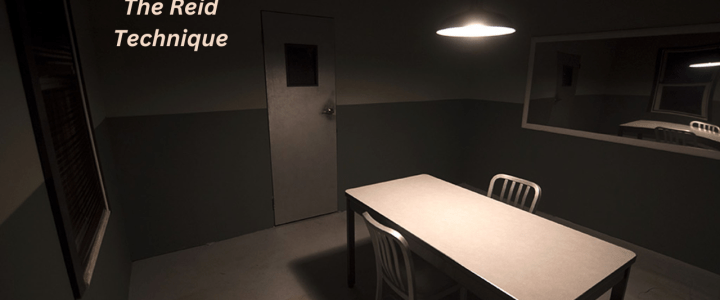The Murder
On the evening of February 24th, 1986, John Ruetten would return home from work to find his wife, Sherri Rasmussen, laying dead on the floor. She was shot 3 times and had a bruise on her face, with a porcelain vase being broken over her head. Sherri also had a bite mark on her arm, that an investigator noticed and obtained a swab of, which was then determined to belong to a female. The case was eventually dropped, being decided as a burglary.
In 2009, however, Jim Nuttal and Pete Barba brought the case back up as their burglar theory was invalid, because of the female DNA. As they investigated the case, more evidence appeared that proved the burglar theory to be incorrect.
Another Investigation
The evidence, before the 2nd investigation, suggested that a struggle began upstairs between Sherri and the culprit, ending at the 1st floor with Sherri dying. More evidence appeared in the 2nd investigation that proved this wrong. At the top of the staircase was a pile of stereo equipment on top of a VCR. If the struggle first began upstairs, leading downstairs, the stack of the equipment would likely have been knocked over, however the equipment was standing upright. For this to happen, the culprit would have had to go back up the stairs and re-stack the pile of the equipment. This is very unlikely to happen as when a burglar succeeds, their main priority is most likely to flee as soon as possible, proving that there was no burglar.
To support this theory, a fingerprint was found on the stack of equipment, but it had no print, suggesting that the culprit had gloves on. The blood was later proved to be Sherri’s, meaning that after she was shot, the culprit stacked the stereo equipment at the top of the stairs to make the case look bigger than what it really was.
From this, the detectives narrowed down their suspects to five females. One of these suspects was a woman named Stephanie Lazarus.
Stephanie Lazarus
Stephanie had dated John before Sherri. Both had never considered that they had major relationships. A bit into their relationship, John had accepted a job to be a hard drive manufacturer, and Stephanie had applied to be a LAPD uniformed officer, and was accepted.
Eventually, John had met Sherri and was then dating her behind Stephanie’s back. Stephanie later learned that John and Sherri have had a serious relationship. Stephanie wrote to John’s mother, “I wish it didn’t end the way it did, and I don’t think I’ll ever understand his decision.”
During John and Sherri’s engagement, Stephanie would often visit the apartment that John and Sherri shared. Stephanie would make excuses like her skies needed waxing. Sherri was bothered by Stephanie’s visits and was beginning to question their relationship. She eventually asked John to tell Stephanie to stop the visits. John responded to her cries by saying that, “They were just friends” and “You should just ignore her.”
It eventually escalated even farther. Stephanie would start to stalk Sherri on the streets. According to Sherri’s father, Nels Rasmussen, Stephanie would visit Sherri in her office and tell her that her relationship with John was not over, and “If I can’t have John, no one else will.”
The two detectives, Jim and Pete, learned that Stephanie was a LAPD Officer, and had been promoted to work on art theft cases as a detective. She was one of the only two detectives in the nation’s full time unit that were devoted to this specialty. She was noted as one of the least promising suspects by the detectives, however, since Stephanie was still in the department, they had to work carefully.
As the investigation continued, they narrowed down the suspects as more evidence appeared. At the end of this, the only suspect left on the list was Stephanie. Now they had to be extra careful; they referred to Stephanie as “No. 5” and would only work after hours.
They proceeded to look into details about Stephanie’s life back in the mid-80’s. They gathered intel from another detective and learned that at the time, the weapon that most officers would use as a backup was a .38. Stephanie used that type of gun. Jim and Pete then supposed that the best time to commit a murder like this, while working for the LAPD, was to commit it on a day off. Sherri had been murdered on one of Stephanie’s days off.
To add even more to the evidence, the murder weapon had been disposed of after the crime. For a police officer to lose or dispose of a major weapon would cause severe penalties, so using a backup weapon would be the obvious choice. As stated before, Stephanie had the same type of backup weapon that was used in the crime.
It was now clear to Jim and Pete that Stephanie was the murderer, but they had to prove it. They worked discreetly and informed superiors about the investigation. The detectives wanted to take a DNA sample from Stephanie. When Stephanie disposed of a cup that she had been drinking from, the detectives swiped a DNA sample from it. When tested, the DNA had matched the DNA from the bite mark on Sherri’s arm. They had found the culprit.
The Arrest
With the careful planning for the arrest, officers waited outside of Stephanie’s home. A short time after they had all lined outside, they received a call from the department headquarters. They requested that the officers would wait at the headquarters instead of Stephanie’s house, as she would be required to give up her equipment there. This would limit the risk of Stephanie retaliation when learning that she was the prime suspect of the murder.
When she arrived, she was asked to talk in an investigation room just to “tie some loose ends” in the Sherri Rasmussen case. While the interrogation went on, she said she didn’t remember most things about the case, since it had been many years since, but seemed to remember some. She admitted to visiting Sherri’s office and seeing John at his condo. The interrogation eventually escalated to the point where Stephanie decided to leave the room altogether. While walking down the hallway, she was met with officers that swiftly put her under arrest.

In early 2012, the trial began for Stephanie. The prosecutors accused that the murder was committed over jealousy from Sherri’s relationship with John. Defense said that Stephanie’s friends denied that she had any violence towards the failed relationship with John. They called their last witness who said that some fingerprints found in the investigation did not belong to Stephanie.
Prosecution showed the jury photos of Sherri and her found body. They said the fight wasn’t fair. The prosecutors reminded that there was no alibi for Stephanie at the time of the murder. Some time in March, Stephanie Lazarus, was convicted of first degree murder. She was sentenced to 27 years to life in prison. She is currently serving her sentence in the California Institution for Women in Corona.
Source: https://en.wikipedia.org/wiki/Murder_of_Sherri_Rasmussen



